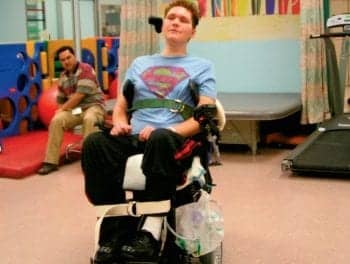Electrically stimulating the severed portion of a completely paralyzed rat’s spinal cord can allow it to walk over obstacles and up stairs, according to a news release issued by Ecole polytechnique fédérale de Lausanne (EPFL). The EFPL scientists also report that they have discovered how to control, in real time, the way in which the rat moves forward and how high it lifts its legs. Watch the rats in motion in this video and learn more about the scientists’ work.
The results appear in the journal Science Translational Medicine.
In the release, Grégoire Courtine, EPFL neuroscientist, explains that the scientists have complete control of the animal’s hind legs. “The rat has no voluntary control of its limbs, but the severed spinal cord can be reactivated and stimulated to perform natural walking. We can control in real time how the rat moves forward and how high it lifts its legs.”
The release states that the scientists studied rats with spinal cords that were completely severed in the middle back, barring signals from the brain from reaching the lower spinal cord. It is here that the release says flexible electrodes were surgically implanted, sending electric current through the electrodes that then stimulated the spinal cord.
The scientists say they recognized a direct link between how high the rat lifted its limbs and the frequency of the electrical stimulation. Based upon this and monitoring of the rat’s gait, the researchers specifically engineered the electrical stimulation to adapt the rat’s stride in anticipation of upcoming obstacles, such as barriers or stairs.
Silvestro Micera, co-author and neuroengineer, explains that scientific discoveries regarding how the nervous system works can be used to develop more effective neuroprosthetic technologies.
“We believe that this technology could one day significantly improve the quality of life of people confronted with neurological disorders,” Micera says.
To further the research, the release says Courtine and Micera, alongside a colleague from EPFL’s Center for Neuroprosthetics, are also exploring the potential of decoding signals directly from the brain about leg movement and using this information to stimulate the spinal cord.
The release also states that the current research builds on earlier work in rats and is part of a more general therapy that may one day be implemented in rehabilitation programs for individuals with spinal cord injury (SCI), currently being developed in a European project called NEUWalk. The release also notes that clinical trials could begin as early as next summer using the new Gait Platform, built with the support of the Valais canton and the SUVA, now assembled at the CHUV (Lausanne University Hospital).
The Gait Platform was designed by Courtine’s team and is comprised of custom-made equipment that includes a treadmill and an overground support system, as well as 14 infrared cameras intended to detect reflective markers on the patient’s body and two video cameras. Together, this generates extensive amounts of information about leg and body movement. The information can then be synchronized for complete monitoring and fine-tuning of the equipment to achieve intelligent assistance and adaptive electrical spinal cord stimulation of the patient.
Courtine emphasizes that the Gait Platform is not a rehabilitation center. Rather, “It is a research laboratory where we will be able to study and develop new therapies using very specialized technology in close collaboration with medical experts here at the CHUV, like physiotherapists and doctors.”
[Source: EPFL]




